Reverse Total Shoulder Replacement (RTSR) is a surgical procedure designed to address severe shoulder conditions like rotator cuff tears and arthritis․ It involves reversing the shoulder’s anatomy to restore function and mobility, offering a solution for patients with complex shoulder injuries․ The procedure is often recommended when traditional shoulder replacement isn’t suitable․ Post-operative exercises and physical therapy play a crucial role in rehabilitation, focusing on restoring strength, flexibility, and range of motion․ A structured exercise program, including light lifting and progressive resistance, is essential for optimal recovery and long-term shoulder health․
1․1 Overview of Reverse Total Shoulder Replacement
Reverse Total Shoulder Replacement (RTSR) is a surgical procedure designed to address severe shoulder conditions such as rotator cuff arthropathy, complex fractures, and glenohumeral arthritis․ Unlike traditional shoulder replacement, RTSR reverses the anatomy of the shoulder joint, positioning the ball on the shoulder blade and the socket on the upper arm bone․ This unique design improves stability and mobility in patients with compromised rotator cuffs․ The procedure is typically recommended for individuals with significant shoulder dysfunction who have not responded to conservative treatments․ It aims to alleviate pain, restore function, and enhance quality of life for patients with advanced shoulder degeneration․
1․2 Indications for Reverse Total Shoulder Replacement
Reverse Total Shoulder Replacement (RTSR) is primarily indicated for patients with severe shoulder conditions, including rotator cuff arthropathy, glenohumeral arthritis, and complex fractures․ It is often recommended when traditional shoulder replacement is not suitable due to irreparable rotator cuff tears or significant bone loss․ Additionally, RTSR is used for revision surgeries to address failed previous shoulder replacements․ Patients experiencing persistent pain, limited mobility, and decreased functional ability despite conservative treatments are ideal candidates․ The procedure aims to restore shoulder function, alleviate pain, and improve quality of life for those with advanced shoulder degeneration or trauma․
1․3 Differences from Traditional Shoulder Replacement
Reverse Total Shoulder Replacement (RTSR) differs from traditional shoulder replacement in its surgical approach and indications․ In RTSR, the ball and socket are reversed, with the ball attached to the shoulder blade and the socket to the arm bone․ This design relies on the deltoid muscle for movement, making it suitable for patients with rotator cuff deficiencies․ Traditional shoulder replacement preserves the natural anatomy and relies on the rotator cuff for stability․ RTSR is typically used for complex cases like irreparable rotator cuff tears, severe fractures, or failed previous surgeries, offering improved mobility and pain relief in such scenarios․

Immediate Post-Operative Care and Exercise Guidelines
Post-surgery, patients wear a sling for immobilization and pain management․ Gentle exercises like pendulum swings and elbow movements are initiated early to maintain mobility without stressing the repair․
2․1 Initial Recovery and Pain Management
Following reverse total shoulder replacement, patients typically experience discomfort and swelling․ Pain is managed with prescribed medications, ice therapy, and rest․ The shoulder is immobilized in a sling to protect the repair․ Patients are advised to avoid heavy lifting or strenuous activities during the initial recovery phase․ Early mobilization exercises, such as gentle pendulum swings and wrist movements, are introduced to prevent stiffness while allowing the shoulder to heal․ Compliance with the prescribed pain management and immobilization plan is crucial for optimal recovery and minimizing complications․
2․2 Importance of Sling Use and Immobilization
The use of a sling is crucial during the initial recovery phase to immobilize the shoulder, protecting the surgical repair․ Patients are typically required to wear the sling for 6-8 weeks, except during prescribed exercises or personal care․ Immobilization prevents excessive movement that could disrupt healing or lead to complications, such as dislocation․ Compliance with sling use is essential to ensure proper healing and alignment of the shoulder joint․ This period of rest allows the tissues to recover, setting the foundation for successful rehabilitation and restoring shoulder function․
2․3 Early Passive Range of Motion Exercises
Early passive range of motion (PROM) exercises are vital to maintain shoulder mobility without stressing the repair․ These exercises involve a therapist or caregiver gently moving the shoulder through controlled motions, such as abduction, external rotation, and internal rotation, without active patient participation․ PROM is typically initiated 1-2 weeks post-surgery, under the guidance of a physical therapist․ The goal is to prevent stiffness and promote healing while minimizing the risk of complications․ Patients are instructed to avoid active movements during this phase, ensuring the shoulder heals properly before progressing to active exercises․
2;4 Pendulum Exercises for Shoulder Mobility
Pendulum exercises are a key component of early shoulder rehabilitation post-surgery․ These exercises involve bending at the waist and allowing the surgical arm to swing gently in small circles or arcs, promoting mobility without active muscle engagement․ Typically initiated 6-8 weeks post-operatively, pendulum exercises are performed under the supervision of a physical therapist to ensure proper form and avoid overexertion․ Patients are advised to perform 3 sets of 30 repetitions, twice daily, holding onto a stable object for support․ Avoid using the non-operative arm to move the surgical arm, as this could disrupt the repair and delay recovery․
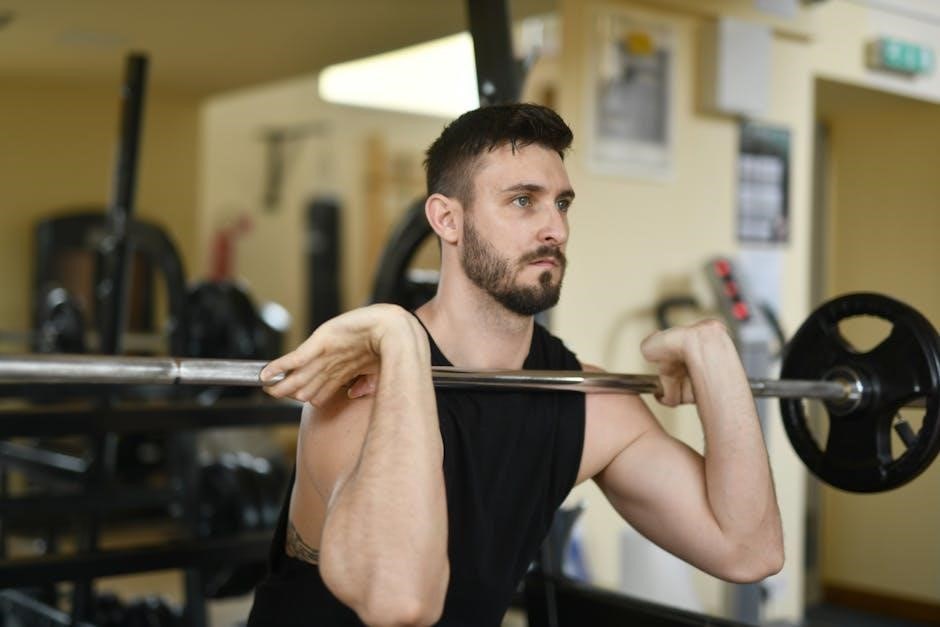
Stage-Specific Exercise Programs
Exercise programs are tailored to recovery phases: 0-2 weeks (gentle mobilization), 2-6 weeks (progressive strengthening), and 3-6 months (advanced mobility and strength exercises)․
3․1 Stage 0-2 Weeks: Gentle Mobilization Techniques
During the initial two weeks post-surgery, focus on gentle mobilization to avoid stressing the new joint․ Use a sling to immobilize the shoulder, promoting healing․ Begin with pendulum exercises to maintain basic mobility without active movement․ Passive range of motion exercises, supervised by a physical therapist, are introduced to prevent stiffness․ Avoid heavy lifting or active movements․ These techniques ensure proper tissue repair and minimize the risk of complications, laying the foundation for progressive strengthening in later stages․
3․2 Stage 2-6 Weeks: Progressive Strengthening
Between 2-6 weeks post-surgery, focus on gradually increasing shoulder strength and mobility․ Introduce light resistance exercises using Theraband to target the deltoid and scapular muscles․ Perform controlled movements, such as internal and external rotations, with minimal resistance․ Incorporate scapular stabilization exercises, like shoulder blade squeezes, to improve posture and stability․ Avoid heavy lifting or overhead work․ Supervised physical therapy sessions are crucial to ensure proper form and progression․ These exercises aim to restore functional strength and prepare the shoulder for more advanced activities in later stages while minimizing the risk of injury or implant complications․
3․3 Stage 3-6 Months: Advanced Strengthening and Mobility
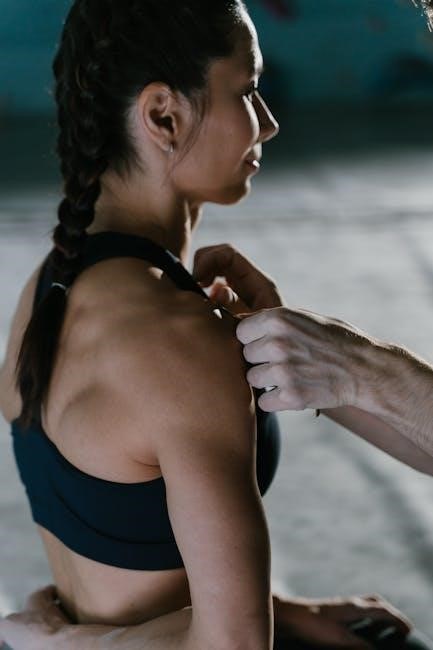
At 3-6 months post-surgery, focus on advancing strength and mobility․ Introduce dynamic exercises like overhead reaches and wall slides to improve flexibility․ Progress resistance with Theraband, incorporating diagonal and rotational movements․ Gradually increase light lifting (up to 5-10kg) and introduce functional activities like light household tasks․ Emphasize scapular strength and stability to enhance overall shoulder function․ Avoid motions that strain the shoulder, such as reaching behind the back․ Supervised physical therapy ensures proper technique and progression․ This stage aims to restore near-normal shoulder mobility and strength, preparing for long-term maintenance and functional independence․
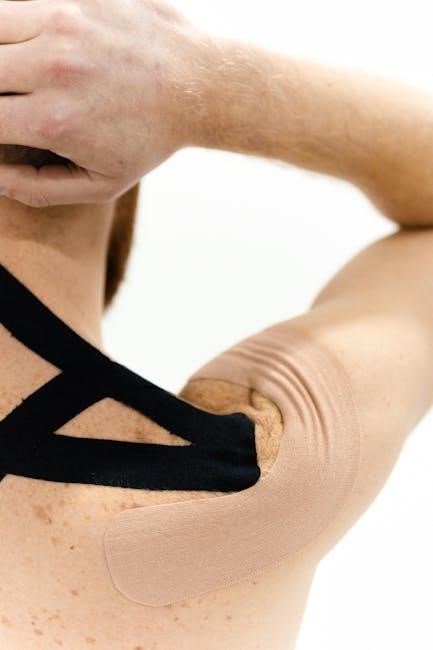
Physical Therapy Protocols
Physical therapy is crucial for recovery, focusing on supervised sessions and home exercises․ Theraband resistance and scapular stabilization are key․ Compliance ensures proper healing and strength restoration․
4․1 Role of a Physical Therapist in Rehabilitation
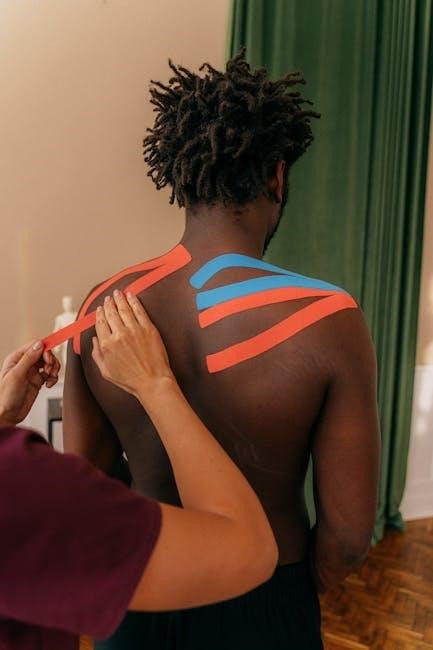
A physical therapist plays a vital role in guiding patients through post-operative recovery․ They design personalized exercise programs, supervise exercises, and ensure proper technique to avoid complications․ Therapists also educate patients on home exercises, emphasizing compliance for optimal outcomes․ They progress exercises as healing allows, focusing on strength, mobility, and functionality․ Regular assessments track progress and address any limitations․ Collaboration with surgeons ensures tailored rehabilitation plans, addressing individual needs and promoting a safe return to daily activities and mobility․
4․2 Supervised vs․ Home Exercise Programs
Supervised exercise programs are conducted in a clinical setting, allowing physical therapists to monitor progress and ensure proper technique․ These sessions are ideal for patients requiring guidance or those with complex rehabilitation needs․ Home exercise programs provide flexibility, enabling patients to perform exercises independently, which is crucial for long-term adherence․ Both approaches are tailored to the patient’s recovery stage and goals․ Supervised programs often transition to home-based exercises as strength and mobility improve․ Compliance with both is essential for achieving optimal outcomes, as they complement each other in restoring shoulder function and promoting a successful recovery․
4․3 Incorporating Theraband Exercises for Resistance
Theraband exercises are a key component of rehabilitation post-RTSR, providing gentle yet effective resistance to strengthen the shoulder muscles․ Patients are often instructed to perform exercises like internal and external rotations, and abduction using the Theraband․ These exercises are typically done in sets of ten repetitions, three times daily․ The resistance level can be adjusted by choosing different band colors or layers․ Consistency with Theraband exercises helps restore strength, improve mobility, and support long-term shoulder stability․ They are versatile and can be incorporated into both supervised and home exercise programs, making them an essential tool for recovery․
4․4 Focus on Scapular Stabilization and Strength
Scapular stabilization and strength are critical in reverse total shoulder replacement rehabilitation to ensure proper shoulder mechanics and prevent complications․ Exercises like wall slides, scapular squeezes, and seated row exercises help strengthen the scapular stabilizers; Patients are often instructed to perform these exercises 2-3 times daily, focusing on controlled movements․ Strengthening the periscapular muscles enhances shoulder stability, improves mobility, and supports long-term functional recovery․ Scapular-focused exercises are particularly important in cases of rotator cuff deficiency, as they compensate for lost function and promote overall shoulder health․
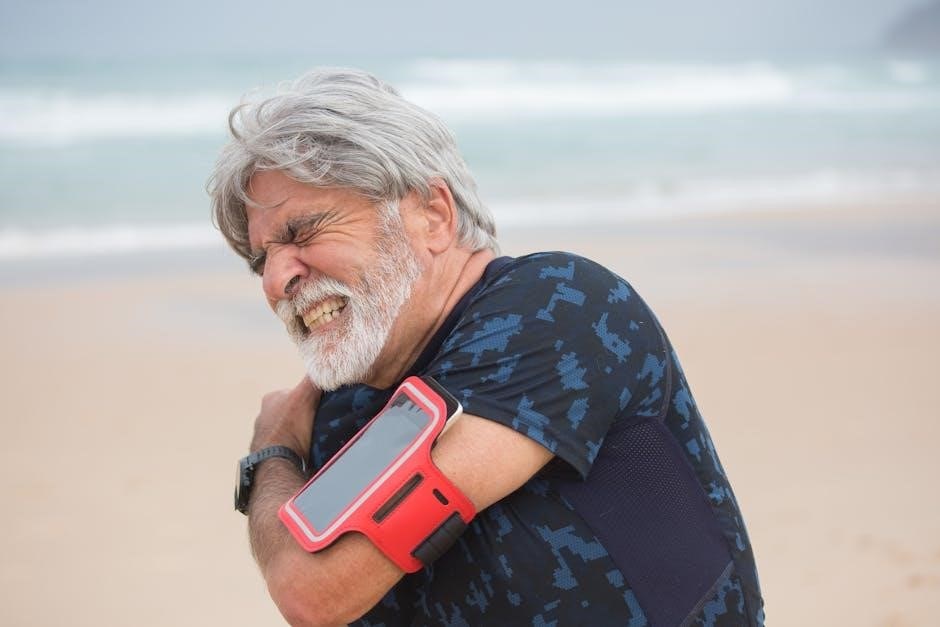
Strengthening Exercises Post-Surgery
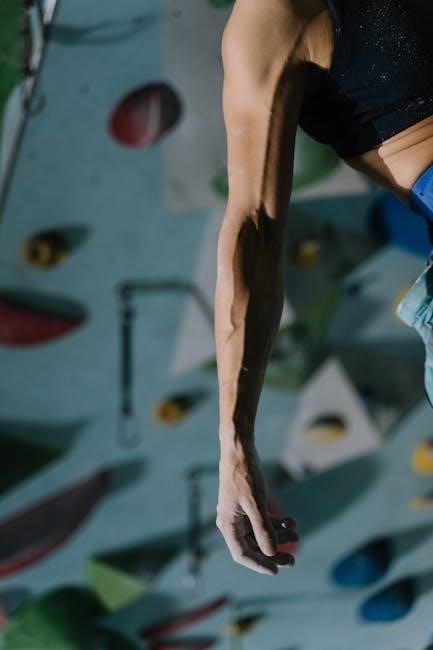
Post-surgery, strengthening exercises are crucial for restoring shoulder function and mobility․ Light lifting, progressive resistance, and theraband exercises are commonly recommended to improve muscle strength and stability․
5․1 Light Lifting and Progressive Resistance
Light lifting and progressive resistance exercises are essential for rebuilding shoulder strength post-surgery․ Patients can start with light weights (5-10kg) and gradually increase resistance․ Theraband exercises, performed in sets of ten, three times daily, help improve muscle endurance․ These exercises focus on controlled movements to avoid strain while promoting stability and mobility․ It’s important to avoid heavy lifting initially and progress slowly under the guidance of a physical therapist․ This approach ensures safe and effective strengthening, supporting long-term shoulder function and recovery․
5․2 Isometric and Active Range of Motion Exercises
Isometric exercises, such as shoulder blade squeezes and wall pushes, help strengthen the shoulder without joint movement․ Active range of motion exercises, like forward elevation and external rotation, improve mobility․ Patients use a towel for internal rotation stretches, gently pulling the arm behind the back․ These exercises are typically pain-free and performed within a comfortable range․ They prevent stiffness and promote joint mobility, crucial for recovery․ Compliance with these exercises ensures optimal outcomes, enhancing strength and flexibility without risking injury․
5․3 Overhead Work and Functional Activities
Overhead work and functional activities are gradually introduced post-surgery to restore daily task performance․ Light lifting (5-10kg) and occasional overhead work (less than 15 minutes) begin around 3-6 months․ Theraband exercises enhance strength and mobility․ Patients perform these in sets of ten, three times daily․ Compliance with prescribed exercises ensures proper healing and prevents complications․ A structured home or physical therapy program guides safe progress, focusing on functional movements like reaching and light household tasks․ This phased approach maximizes recovery while minimizing injury risk․

Precautions and Contraindications
Post-surgery, avoid shoulder motion behind the back and limit heavy lifting or overhead work․ Compliance with exercise programs is crucial to prevent complications and ensure proper healing․
6․1 Avoiding Shoulder Motion Behind the Back
Avoiding shoulder motion behind the back is critical post-surgery to prevent dislocation and promote healing․ Patients should refrain from reaching backward, such as touching the lower back or placing hands in back pockets․ This precaution helps protect the repaired tissues and ensures proper alignment of the shoulder joint․ Using adaptive equipment, like reachers, can assist with daily activities without compromising the shoulder․ Compliance with this guideline is essential for a successful recovery and to minimize the risk of complications․
6․2 Limitations on Heavy Lifting and Overhead Work
Patients should avoid heavy lifting and prolonged overhead work to protect the shoulder joint and ensure proper healing; Lifting weights exceeding 5-10kg is generally discouraged, especially in the early stages of recovery․ Overhead activities, such as reaching or carrying objects above shoulder level, should be minimized to reduce strain on the implant․ These limitations help prevent complications like dislocation or hardware failure․ Using assistive devices or seeking help for heavy tasks is recommended․ Compliance with these guidelines is essential for a successful recovery and to maintain the longevity of the shoulder replacement․
6․3 Importance of Compliance with Exercise Programs
Adhering to prescribed exercise programs is crucial for optimal recovery after reverse total shoulder replacement․ Consistent performance of exercises, such as Theraband resistance training and scapular stabilization drills, ensures proper healing and restores shoulder function․ Non-compliance may lead to reduced mobility, strength, and increased risk of complications․ Patients should follow their physical therapist’s guidance and maintain a regular routine․ Compliance not only accelerates recovery but also enhances long-term outcomes, allowing patients to regain independence in daily activities and maintain shoulder health effectively․ Regular follow-ups with healthcare providers further support adherence to rehabilitation protocols․
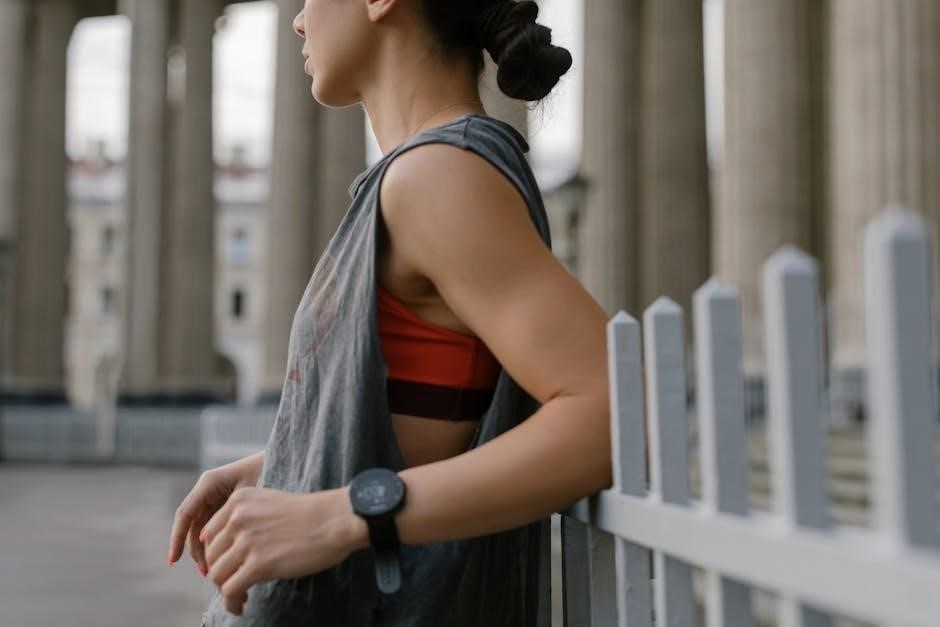
Long-Term Recovery and Maintenance
Continuing strengthening exercises and maintaining shoulder mobility are vital for long-term recovery․ Regular follow-ups with healthcare providers ensure proper progress and address any concerns, promoting sustained shoulder health;
7․1 Continuing Strengthening Exercises
Continuing strengthening exercises is crucial for long-term recovery and maintenance after reverse total shoulder replacement․ Light lifting and progressive resistance exercises help maintain shoulder strength and mobility․ Theraband exercises, such as resisted rotations and scapular stabilization drills, are commonly recommended․ These exercises should be performed in sets of 10-15 repetitions, 2-3 times daily, to ensure consistent progress․ A structured exercise program, tailored by a physical therapist, promotes sustained functional improvement․ Consistency in these exercises ensures lasting shoulder health and prevents future complications, allowing patients to maintain independence and perform daily activities with ease and confidence․
7․2 Maintaining Shoulder Mobility and Flexibility
Maintaining shoulder mobility and flexibility is essential for long-term recovery after reverse total shoulder replacement․ Passive range of motion exercises, such as pendulum exercises and gentle internal rotation, help preserve joint mobility․ Patients are encouraged to perform these exercises regularly, using a towel for assistance if needed․ Avoiding shoulder motion behind the back is crucial to prevent complications․ Consistent practice of these exercises improves flexibility, reduces stiffness, and enhances overall shoulder function․ Regular mobility exercises also support daily activities and promote a full recovery, ensuring the shoulder remains functional and comfortable for years to come․
7․3 Importance of Regular Follow-Up Appointments
Regular follow-up appointments are crucial for monitoring the healing progress and ensuring proper rehabilitation after reverse total shoulder replacement․ These visits allow the surgeon to assess the shoulder’s recovery, verify implant stability, and address any concerns or complications․ Imaging studies, such as X-rays, may be conducted to evaluate the shoulder’s alignment and healing․ Patients should adhere to the recommended follow-up schedule to ensure optimal outcomes․ Regular check-ups also provide an opportunity to adjust the exercise program and address any questions or concerns, promoting long-term shoulder health and functionality․